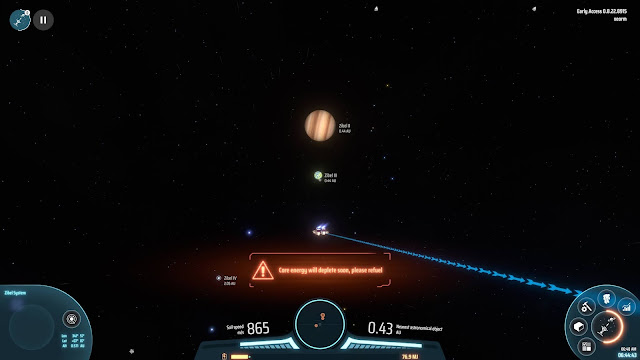Logistics Towers
I made it back safely to the bootstrap base. That was a fun little scare. Nothing major, but hey, when you're all alone even small bits of craziness like that can be fairly shocking. Forever onwards though. Now that I have the titanium and processors from the mining base, I can begin construction of the logistics network. My habit until now is to bring the resources via belt to a location near where I've built all my other buildings, and then had the fabricators produce the items for me. But not this time! I want to use these damned things finally.
I have the Icarus construct a few using its onboard fabricator. It's slow and annoying, but the first few pop out, and I indulge myself.

Don't ask me how the Icarus could construct those, much less carry around multiples of them.
See how disorganized and sloppy that looks? Welcome to the power of the logistics system! Each of these planetary versions can store up to 50 logistics drones and have three types of items each. Each item it can choose to either supply to the logistics system or demand from it. In this case, I have a tower that is demanding the three items I'd need to produce more planetary towers. Plus one from the lower tower. Each drone consumes power for flight proportional to distance, but power is essentially free and the ease of construction means I'm not too worried about them.
All of which means that once I plug in the materials into the system, I'll be able to demand from anywhere. Halfway across the world? No problem. I can tweak the settings too if I'd like, but for now this should work out fine.
But why bother? The sloppiness is intentional to a degree. The quicker I can construct buildings, the quicker I can build the dyson sphere. Having to carefully construct transport lines so I don't muck things up later takes valuable time, and I'd rather not waste it if possible. There's also the relation of raw materials to outputs and further down the chain. As I mine out worlds the production will by necessity be decreased. Under the old system that means that unless I go back and tidy things up items further down the chain will slow production as well. By adding things to a larger network I can much more easily notice changes in production and change them. Lastly there's the problem of splitting and evening out lines getting more problematic. The preference is that I have a guaranteed input line to each fabricator where I know how much is being added. The shared pool will even that out as well, so I don't have to worry that I have one line only producing 75% of what it could while another is producing 50%, as an example.
Middle Managers In Space
I won't change things immediately. But this is a major change that has me fairly excited. And it seems like the "supervisors" back home have rolled out some new initiatives. Namely some goals they'd like me to reach, and little awards to give when I hit certain thresholds.
 |
| I mock a little, but I do like achievements to pop up when I hit bits like this. And goals to hit are great for new players to use as guidelines |
Back to base building. Obviously nothing is going to come out of these towers unless I build other towers to supply the materials, so that's next on the list. My plan is to only introduce items steadily to the transport network. Working backwards of a sort. There's no reason to tear up the infrastructure I already have right at this point. But any new construction is going to go through the system, so it'll gradually end up being on these lines. And that's for this planet. It's coming up soon where I'll be expanding further out, on multiple planets. That'll be quite the experience.
 |
| Each tower can have some drones in it. These drones can fly to collect items, or to deliver them |
Isn't it pretty? The sky will be bustling here shortly as I increase logistics usage. Thankfully the onboard processors are good about managing collisions so I shouldn't have to worry about them at all.























